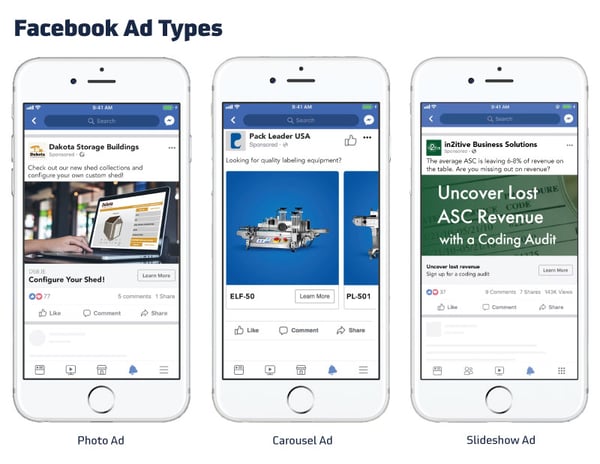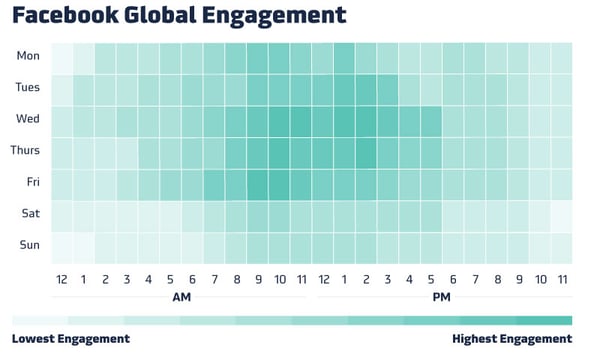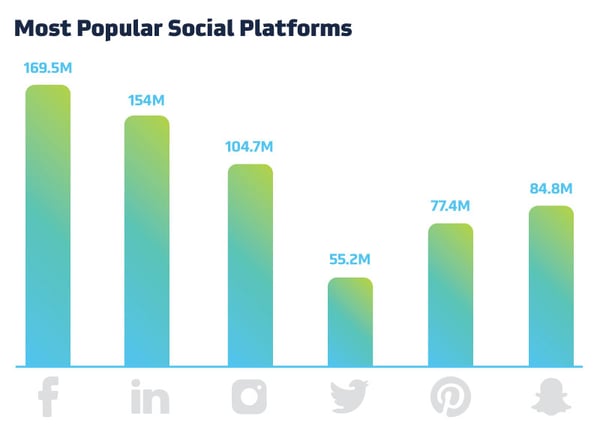Social media marketing is always growing and expanding — make sure you don’t get left behind.
We live in a world where people are constantly connected and can get anything with the click of a button. How can you make sure your business is a part of that? Social media may seem like a beast, but if used correctly, your consumers will want to build a personal relationship with your brand. 78% of consumers say that relevant social content increases interest and purchase intent, according to Social Media Today.
Figure Out Your Social Media Marketing Goal
The first, and perhaps the most important step in conquering social media marketing and your use of social media platforms, is figuring out your goal.
Ask yourself: why are we on social media, and what do we want to get out of it?
If you plan on using social media to engage with your audience within a specific industry, then you need to interact with the right people and follow the right accounts. Get your name out there and become a recognizable brand that people can see as thought leaders and industry experts.
If your main goal for social media is to promote sales, then paid ads and promotions could be the best option.
Social media can be used in specific ways based on your goal. According to Hootsuite statistics, 3.48 billion people use social media; this is an increase of 9% from last year. To put this into perspective, that means that 45% of the total world population is on a social platform. This is a great opportunity to network, expand your brand, increase awareness, and put your product or service in front of many social media users. But, before getting carried away, make decisions based on your goal not whims or the latest trend.
Be Ready to Engage
Social media allows people to interact directly with brands, see reviews from others, and ask for recommendations. The possibilities are endless for consumers. This can be positive for brands but also can hurt a company if a bad review is given.
The key to combating a bad review is not to delete it, but to respond to it. People leaving a review on social media want to feel heard, and by responding to that review, you can accomplish two things. First, after dealing with the reviewer who left the complaint, hopefully, you can identify steps that will help gain back their trust. Second, establish trust with potential consumers looking through reviews. If a company has taken time to adequately address negative reviews, potential consumers will likely view the company as human and genuine and will often read the negative review with a grain of salt.
According to a Hootsuite study, after interacting with a brand on Facebook, 66% of people feel more confident about the brand, and 55% feel more personally connected to the brand.
As you engage with your audience, keep your brand guidelines in mind. Make sure the voice and tone you’re using not only fits your brand but resonates with your customer base. Remember that people are looking to interact with brands on a human level, so showing your personality is important. For instance, whether that personality is sincere and witty or clever and sympathetic, giving your brand a voice and keeping consistent will prove beneficial.
As you think about your social media marketing plan, keep these things in mind.
Timing is Everything
The world of social media is all about being timely. Knowing when your audience is most likely going to engage with your posts and what they are interested in will help you determine the best time to post. Every audience is different, but there are some general guidelines to get you started.
Sprout Social’s engagement report shows when Facebook users are most active. According to the study, the best times to post on Facebook are Wednesday, Thursday, and Friday between 11 am and 1 pm. You can read through more of the findings and explore other platforms here.
Another aspect to consider as you create your social media marketing plan is the value and benefits of being a part of conversations that are happening in real time. If there is an industry-related release or news update, it is important to join the conversation while the topic is relevant— not two weeks later. The beauty of social platforms is consumers can now interact with businesses on a human level and form greater connections with a brand and often in real time. But how can people connect with you if you aren’t there? So, how can you get there? This is where hashtags come in!
Use Hashtags
Hashtags have been around since 2007 and have increasingly grown in popularity, but it can be a tricky task to utilize them for your benefit. So let’s start by defining exactly what a hashtag is and why you should use them.
A hashtag is a social media tagging system that categorizes content based on their use. Posts using hashtags are viewable by anyone with an interest in that thread, and they expand your brand’s reach beyond just your followers. Hashtags are free to use, and a simple way to get your brand a part of any conversation.
Be specific with your hashtags, but keep it simple. No one can read a #fiftywordhashtagthatprobablydoesnotmakesensewithyourpost. See what I mean? People don’t want to have to take time to decipher what your hashtag is trying to say. Keep it short and sweet. But make sure your hashtag is relevant to what you are saying. Don’t just find the most trending hashtag and start overusing that because your post will get lost.
For example, in 2018, the most trending hashtag on Instagram was #love. Users were filling their profiles with feel-good images. If your post doesn’t fit into that category or have anything to do with that topic, don’t use the hashtag.
It is important to research which hashtags are popular, what the industry is responding to, and most importantly, what the hashtag is being used for by other users. Too many companies skip the last piece because they believe that if it’s trending, then they want to be a part of it, but that should not always the case. You don’t want your brand to be associated with a conversation that either is inappropriate or harmful.
Find Out Where Your Audience Is
There are so many social media platforms — from Facebook to Pinterest — that it can be overwhelming when you’re getting started. The simple answer here is don’t bite off more than you can chew! When picking your platforms, the key is finding out where your target audience is spending their time and focus your efforts there. Also, keep your social media goals in mind. Refer back to your social media marketing plan to make sure your time and effort are focused on your target.
Here’s an example. If you’re targeting business professionals who spend all of their time making connections on LinkedIn, it doesn’t really make sense to post all of your best posts to Instagram. You will feel discouraged because it's not the right social channel. Regardless of your goal, you won't hit it if you're not reaching your target audience.
According to statistics, in 2018, in the U.S., Facebook was still the most popular platform with 169.5M users, and LinkedIn came in at second with 154M users. Instagram had 104.7M users, while Twitter is still growing in the U.S. with 55.2M active users. While each industry is different, you may want to focus on a specific platform or two so that you can reach your goal.
Locating your audience will ensure your efforts aren’t wasted and that you get the results you want. Plus, your consumers can build a relationship with your brand and gain insights. It’s a win-win situation when you put in just a little bit of work up-front.
Pay for Ads
You might be thinking that spending money on social media may seem like a not-so-great investment, but you have to remember your goals. In order to gain a quality audience, you have to reach the right people. Our tech-centric world is full of ways to get the right info to the right people, and social media platforms have algorithms to ensure that. Consider the benefits of social ads when you create your social media marketing plan.
Facebook and Twitter automatically target your ad to users that have shown interest in what you’re advertising. It’s important to read up on how each platform works so that you know how to best interact with your audience. Facebook and Instagram offer targeted ads based on the location, demographics, and profile information of users. LinkedIn has targeted ads based on traits like a consumer’s job title, company name, and their industry or professional interests.
Advertising on social media pushes the right information to the right people and ensures it gets to them at the right time. A typical Facebook user will click on 8 Facebook ads that pertain to them per month.
There are several different types of ads for each platform, so your ad can be customized and branded. From carousel ads to slideshow ads, each type has specific benefits that you can utilize to get your brand into the social conversation. Learn more about the benefits and types of Facebook ads.

Only around 2% of people will make a purchase the first time they visit your website, it’s important to make sure they don’t forget about you or your brand. Social media advertising is a great way to target your audience based on profile information and their interests while keeping your brand top-of-mind.
Check Out These Great Social Media Accounts
Want to see some of these techniques utilized in real-time? Check out a few big brands who have a stellar social media marketing plan in place and are truly mastering social media.
Twitter | Wendy’s: The Wendy’s brand is a great example of a Twitter account actively engaging with consumers using a witty tone. This extremely popular account has garnered expansive brand awareness and a huge return on investment.
Facebook | Shopify: This brand has figured out exactly what posts their consumers respond to and when. Shopify found that their consumers engaged with videos and testimonials, so capitalizing on those concepts has allowed them to interact with their consumers.
LinkedIn | Yelp: Using hashtags on LinkedIn might not be your first instinct, but Yelp is a great example of using hashtags to the brand’s advantage. Yelp showcases their company culture as well as promoting helpful content for their audience.
It’s Time to Get Started
There are so many things we could talk about when it comes to social media marketing and each social media platform, but you have to start somewhere. Once you have done the research and set your goals — it’s time to get started! Keep your eye on the prize and don’t be afraid to ask for help if you aren’t getting the results you wanted.
Curious to see how we’re handling our social media? Check out our social media platforms — and let’s get connected!
Need help with your social media marketing strategy and execution? Learn more about our Digital Marketing services.
Subscribe to Our Blog
Stay up to date with the latest marketing, sales, and service tips.





